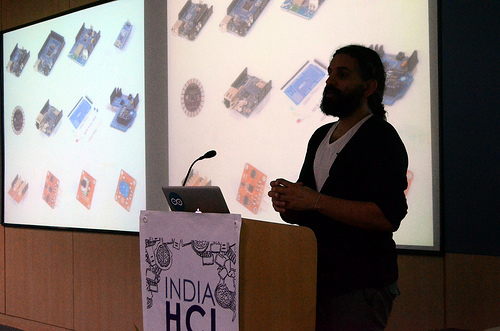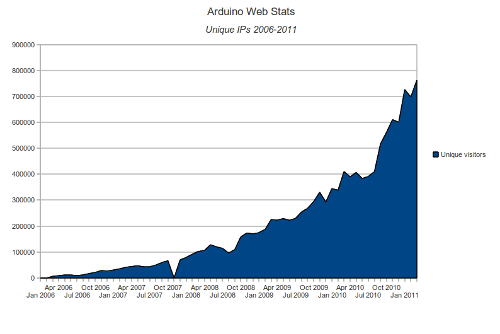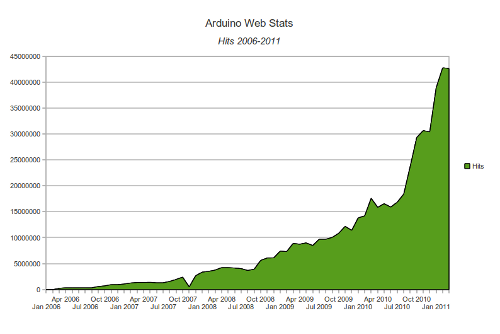WEFAB DAYS 14-16 APRIL 2011 IN MILAN
– April 13th, 2011
As you can see from the video above (Cristian and Costantino just look great in making their first Makerbot), we are witnessing a sudden awareness about FabLab and the power of Fabbing in Italy. You can join the wefab guys in Milan during the Salone and get your hands in making your own design!
WeFab is a three-day event during the Milano Design Week. It is hosted byOpenWear a collaborative clothing platform, and by Vectorealism, a digital fabrication facility based in Milan.WeFab offers Milano Design Week’s visitors a way to explore creative possibilities with new technologies such as 3D printing and laser cutting but also the new opportunities that open source approaches and collaborative processes can bring to the creative sector.WeFab exhibition will feature objects, workshops, installations and performances that explore the cross-fertilization of new production technologies and collaborative ways to design and make products.Highlight of the WeFab program is the Design Smash contest, where designers from all across Europe will go from idea input to output of real object/accessory by the end of the evening.There will also be a conference session hosted by the University of Milan, as well as workshops about making products by using Arduino with Solar Panels WeFab’s location is a club near Zona Tortona, which will feature with three full days of live music shows, dj sets and will host a temporary shop selling handmade productions.
via [wefab]
MORE LUFA HACKS: KEYBOARD, MOUSE, AND MIDI.
– April 12th, 2011
[Darran] played around LUFA firmwares on the Arduino UNO and Arduino 2560. It seems now LUFA hacking is getting more and more common among Arduino users.
I’ve published the source, hex files, and sample sketches for Keyboard HID, Mouse HID, and USB MIDI drivers for the UNO and Mega2560 onhttp://hunt.net.nz/users/darran.The LUFA project has made this fairly easy to do which is great, the only drawback is the limitation of only 4KB of flash space for the driver in the atmega8u2.
via [hunt.net]
ARDUINO DAY A ROMA, 14 APRILE 2011
– April 11th, 2011

Il prossimo 14 aprile (giovedì) Massimo parlerà a Roma in occasione dell’Arduino Day, una giornata di conoscenza delle possibilità di Arduino a livello didattico e formativo. Le possibilità Arduino come mezzo educativo nelle scuole era stata presentata a fine dell’anno scorso in occasione di questo evento a Torino, seguito da un corso tenuto da me presso alcune scuole del circuito Dschola. Ora grazie all’associazione discienza abbiamo la possibilità di parlare a Roma, e finalmente conoscere un po’ di realtà locali.
Arduino Day è una giornata dedicata a far conoscere a docenti, ricercatori, artisti e ragazzi la piattaforma Arduino.L’iniziativa, organizzata dall’associazione per la divulgazione scientifica DiScienza, nasce con l’obiettivo di catalizzare il sempre maggiore interesse nei confronti del progetto Arduino, e di convogliarlo in un’unica giornata in cui sarà possibile conoscere le diverse realtà che utilizzano la piattaforma e approcciarne alcune applicazioni.
segui il [thread sul forum di Arduino].
ARDUINO AT HCI INDIA 2011
– April 10th, 2011
Today I presented Arduino at HCI India 2011 as one of the keynote speakers. It is interesting to get a chance of introducing my research in the field of prototyping and the work I do for Arduino all at once to the HCI community in India, which is strongly focused in the creation of software solutions. I attended the track where the Full Papers were presented and got to see a whole lot of projects where Interaction Design and usability techniques are applied to study the use of mobile technologies to help illiterate people getting access to micropayments, learning about irrigation, or just learn how to read.

(cc-sa-nc) 2011 D. Cuartielles at HCI India
The other three keynotes went from the very theoretical to the extremely practical. PhD. Mark Billinghurst spoke about the future of Augmented Reality and made some nice demos of the software they are developing at HitLabNZ.PhD. Kari Rönkkö from the Technical University Blekinge (BTH) presented his thoughts around the concept of “Wicked Problems” after designing a whole educational computer system together with ABB. And Prof. M.P. Ranjan, now retired after over 40 years at the National Institute of Design, provoked the audience with his visions on how to approach design thinking and how the educational and value system should be improved in India.
My demo was a walkthrough to the use of ArduinoBT + Processing + Android to conceptualize about the Internet of Things. It worked just great and I had people to program graphical behavior patterns on an Android’s screen by drawing how an LED should fade or a motor should move. I am making a post about this technology that was developed by A. Goransson, D. Sjunnesson and myself during the last month.
Talking about the papers, there were two papers on security that I found interesting as a topic for HCI professionals. Can you imagine designing a password system based in icons for people that cannot read nor write?NAPTune: Fine Tuning Graphical Authentication Rohit Khot, Kannan Srinathan and Rutuja Khot got the conference award to the best research paper and I think it was well deserved.
It was really a pleasure to be among such a selection of speakers, panelists, companies, students and practitioners. Arduino was present and we had fun. IIITB -the International Institute on Information Technology Bangalore- was a great host and the Lord hotel served the best food I have had in India so far (I am living on campus for three weeks, that could be a good explanation for this last statement not that the food here is bad, but that my experience is limited to just two places).
I have to add that there was a lot of video tracking going on at HCI India 2011. Tommy from Tobii presented his slideshow by using only the movement of this eyes. Tobii is a Swedish company specialized in eye tracking that has released a prototype of a laptop with Lenovo including this feature. Also I liked very much the approach to social design by Microsoft Research team. I got someone (Ed Cutrell) to rebate my understanding of HCI vs. IxD and I think I got convinced, but I will figure out a way of turning it around.
BTW, it seems like India is in the need for interaction designers. If you guys are looking for a good job in the field, check out the companies that were present both as sponsors and at the company presentations, because they are hiring. Remember you have to be open minded, have good communication skills, like research, and have an entrepreneurial spirit.
TEACHING ARDUINO IN SEATTLE
– April 7th, 2011
Andrew Davidson is running a high school class named “Intro to Computer Science” at Roosevelt High School, in the Seattle Public School district of Seattle, Washington. His relationship to the Arduino project goes back to Ivrea, where he used to work at the very same location where we created the small blue boards.
At his course, students will be introduced to programming using Scratch and Processing, and to physical computing using Arduino boards. As Andrew mentions on the official course announcement:
Through a project-oriented approach, students will create a variety of software applications and systems. By collaborating in a hands-on environment, students will learn problem solving, software design and programming, debugging strategies, and the fundamentals of computer science (data structures, procedures, and algorithms). We will use a variety of programming systems that are not only creative and highly interactive, but also provide an engaging way to learn the practice of software engineering.Students will work on projects (both individual and team) in the areas of graphics and games, animation and art, electronics systems, and interactive fashion. The software used to create the projects will be open-source packages such asScratch, Processing, Arduino, and LilyPad.
We really want to reach out to highschools and, if possible at even lower levels. We are preparing something new for this (but we are not going to reveal it yet). We want to help to all of you preparing curriculum for schools in making the best out of teaching. For the time being, if you are in doubt whether it is possible to teach with open source tools to kids, just take a look at Andrew’s course, there is even a calendar showing how to structure the assignments over several weeks (please note that, at the time of posting this, the Arduino assignments weren’t there yet).
MACKLIN CHAFFE’S GOLDEN ORB IS THE NEW OSH’S LOGO!
– April 7th, 2011
There is a brand new logotype for the Open Source Hardware initiative, as Ayah reported on this blog post:
The results of the public votes for the OSHW logo are in! Almost 9000 people voted, and the community selected “Golden Orb” by Macklin Chaffe as the OSHW Logo v1.0 (submitted on Feb 11th, 2011).
Congratulations Golden Orb and thank you all for voting!If you support the OSHW Definition 1.0, you can GO AHEAD and USE, PROMOTE and Apply the OSHW Definition and logo to you projects and circuits. Here’s to another great day for Open Hardware!
Thanks again to Phil, Dale, Mako, Alicia, John, Bruce, Dave, Windell, Juergen&Tuomo for helping out
Via the Open Hardware Summit Website, thanks Ayah for the link! See the whole results here.
THE RHYTHM OF CITY
– April 7th, 2011
This is an art project born as the collaboration between Varvara Guljajeva and Mar Canet. During the last couple of years they have been collaborating in the creation of several interactive installations, some of them containing Arduino boards. The Rythm of City is about to be presented in the following weeks at the Czec Festival Enter5 and has pretty good online documentation, so I think it is interesting to show it here.
The Rhythm of City(2011) is a mixed reality real-time artwork that applies geo-located social data for an artistic purpose. It is an art installation that explains in original way digital geo-located social content and characterizes cities [...] Moreover, we would like to give an alternative meaning and purpose to the location-specific invisible online data. In short, the artwork makes invisible information visible and even audible.[...] Important thing is that we do not rely on single social network but multiple. At the moment we are applying Twitter, Youtube, and Flickr. We plan extend our selection.
The installation controls 10 metronomes via servomotors using one Arduino Mega2560, The data to decide whether the metronome should be active and how active it should be is taken from geo-tagged posts to social networks. The following video hints how it works with 5 linked cities represented by 5 metronomes:
For more information visit Varvara Guljajeva or Mar Canet‘s personal websites,this blog explaining the process, the technical diagram, or the festival page with information where to see the piece in action this April.
SEGWII: SELF BALANCING ROBOT WITH ARDUINO + WIIMOTE
– April 6th, 2011
Hello I am Tijmen Verhulsdonck 17 years old and come form the Netherlands. In the past six months I have been working on a self balancing robot (SegWii) that you can control with a Wiimote. I got the idea from Ara Kourchians, he thought of the idea to remote control a self balancing robot with a Wiimote. He never succeeded in connecting the Wiimote to an Arduino [...]Hey thats the great thing about open source someone else could pop up and finish your idea.
Tijmen came with the idea of taking over an existing project to improve it. Six months later he was posting his videos online and even came on the Dutch TV(you need to understand Dutch for this). If you check his material you will see how clean the loop turns out. An important part of a project is to get it work, but if at the same time you make clean code, then you are making it much more accessible to others.
His design, as many we have seen in the robotic’s scene lately, includes two Arduino boards. One is dedicated just to handle the communication with the wiimote, and a Mega2560 taking care of the whole rest. There is even a 25×4 screen to display information to the user.
For more information, visit Tijmen’s post on letsmakerobots.
GEIGER SENSORS NEEDED FOR JAPAN
– April 5th, 2011
I am not sure we have been echoing these news, so I am going to write a short blog post after having a chat with Shigeru Kobayashi, the maker of the Arduino FIO, Gainer board and Funnel IO. A small community of Japanese makers are building a network of sensors monitoring the radiation in the air and sending the data to Pachube.
Turns out they are out of the sensors they need to send their data to the internet. This is a call for help finding more of those sensors to help Shigeru and the others monitor the quality of the air. This is what he mentioned during our conversation:
At current moment, SparkFun’s is out of stock, but will be back by the end of April. A hobbyist is working on a russian tube based counters. And Seeed Studio is also working.
The group at Tokyo’s hackerspace, as we informed earlier, is using a hacked Geiger counter, as reported on March 24th:
Unfortunately, geiger counters were sold out everywhere. The fear of nuclear disaster and radiation spread internationally and there was a run on geiger counters. Luckily, Tokyo Hackerspace was able to obtain two of them fromReuseum . They had actually bent over backwards getting them to us quickly and was calling their warehouse for stock and UPS and FedEx to see who would still deliver to Japan. We received them two days ago and I brought them to Tokyo Hackerspace yesterday to show people how to use it. We’re keeping one at the space so that people can borrow it to check out their living area and reassure their families that its safe.[...] I decided that this geiger counter would reside outside on my balcony, although inside a cardboard box. The reason for this is that most of the geiger feeds in Tokyo right now are indoors and I noticed a larger variance in geiger measurements outdoors versus indoors. I checked the measurements of this geiger inside my apartment and they follow closely with the official government numbers as well as other geiger counters around Tokyo. I figured its better to have it outdoors so that people can get an idea of what they’re being exposed to when walking around. Most of the fallout is particulate matter. As a point of reference, the normal background radiation in Shinjuku is 0.035 uSv/Hr .
This said, if you happen to be seating on top of a box of anything that can monitor radiation, please answer this blog post or send an email to team [at] arduino [dot] cc, we will put you in touch with Shigeru. I think I speak for the whole Arduino Team if I say we will correspond your generosity/help by also contributing to this project.
Links for more information: send your data feed to Pachube (in Japanese),Pachube’s blog post about radiation measurements, data feeds as made by Shigeru, and the Japan Geiger Map,
STATISTICS ARE SKYROCKETING
– April 5th, 2011
We are lucky to have been keeping track of our data more or less since we started. After 6 years online we can now show the graphs displaying the evolution of our website from 0 to 750.000 users per month. We are aware network monitoring is an art and that we probably don’t have the best tools to show our numbers, but the values are remarkable anyway. Here the graphs for amount of unique IPs during the last years, as well as the hits/month, where we are about to reach 45.000.000 in total for a 31 days period. The users and hits increased by factor 2x and 3x respectively during the last year.

(cc-sa-nc) 2011 Arduino Team
A deeper analysis of the data shows how it is around March-April every year that the server gets the biggest load and how things stabilize again until September … I wonder how many of our users are students going crazy looking for information on the website during the project implementation phase of their classes.
I should note that there is much more data in our system that I am still digesting. For example, most of Arduino users access out system from a Windows computer (70%), Mac OSX users have a share of 14% while Linux keeps a honorable 11%. The rest goes for all sorts of weird devices that get to browse our site … are there still Symbian phones out there?
As a happy Open Source user, I am proud to announce that FireFox is still going strong as the main browser to visit the site (40%) … let’s see if the latest FF4.0 will get those numbers to improve over the following months.

(cc-sa-nc) 2011 Arduino Team













0 comentarios:
Publicar un comentario